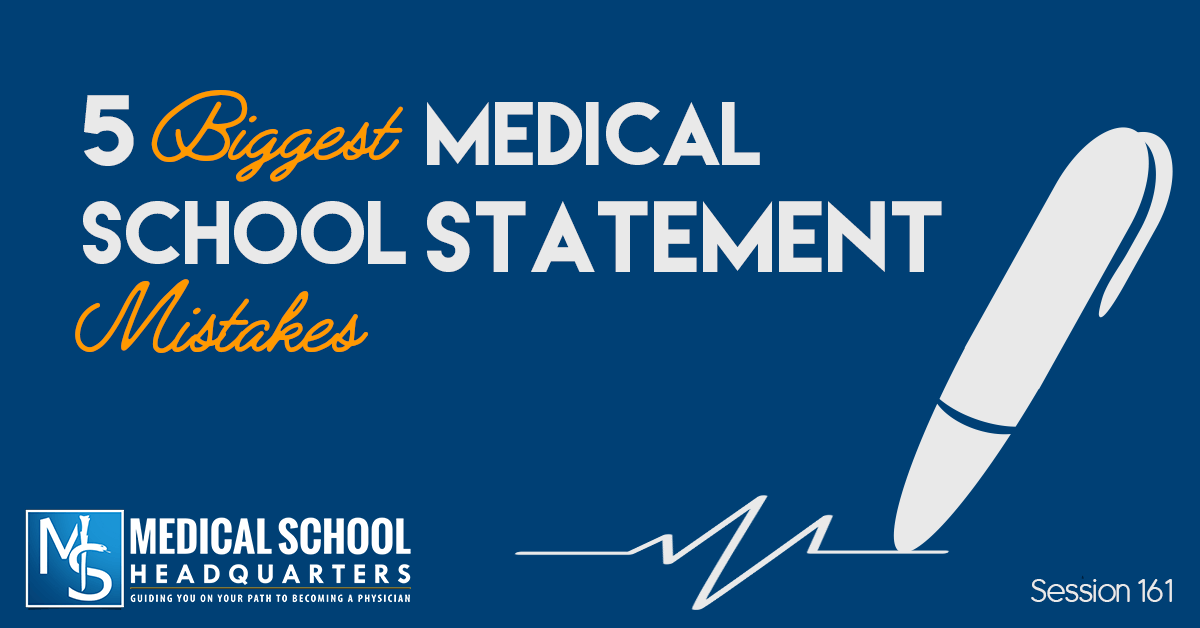You still have time to sign up with one of our amazing expert advisors! Learn More!

In today’s episode, I talk about the common pitfalls in writing medical school personal statements and how you can avoid them.
Personal statements (right behind interviews) are where students fall short in their applications. The personal statement is an essay about you and your journey. You’re trying to convey to an admission committee why you want to be a doctor, your motivations, what’s shaped you, and your life experiences.
After reviewing hundreds of personal statements, I’ve identified common trends and pitfalls in the preparation and execution of personal statements, which I will share in this episode to help you avoid them.
Listen to this podcast episode with the player above, or keep reading for the highlights and takeaway points.
Since this episode came out, I’ve published a book all about the medical school personal statement! If you find the following tips helpful, be sure to check out my book for more advice: The Premed Playbook: Guide to the Medical School Personal Statement.
Here are the most common mistakes students make in their personal statements:
Premeds tend to focus more on things like the MCAT, getting together their extracurricular activities, writing descriptions for each of those, and getting their letters of recommendation done. While all of these are important, students fail to take enough time to go through writing several drafts for their personal statement.
What you need to do: Write a draft, and write it again (and again and again). Get feedback on all these drafts from people who understand what the admissions committee wants. Show your premed advisors, for example. I also do personal statement editing if you’re interested in having me take a look. Overall, you should set aside time to go through at least a half a dozen drafts over at least a month and a half.
Set aside time to go through at least a half a dozen drafts of your personal statement over at least a month and a half.Click To TweetPremeds tend to edit what they’re trying to write in their head. This leads to students feeling a lot of inhibitions while writing.
What you need to do: “Write drunk and edit sober,” which means you need to be uninhibited as you write. Don’t worry about what you’re typing or writing. Just get it out of your head. Don’t think about what you’re writing—just get your thoughts out of your head. Once you’ve done this, then you can start massaging the message and crafting it into a strong personal statement.
For the first draft of your personal statement, don't think about what you're writing—just get your thoughts out of your head.Click To Tweet[Related episode: How to Start Brainstorming Your Personal Statement Draft?]
The admissions committee wants to see your passion and desire for going to medical school. And that is the fundamental message that you need to get across the admissions committee.
What you need to do: Hand your personal statement to somebody and ask them, “When you read this, do you understand why I want to be a physician?” If they can’t answer that, you need to go back to the drawing board and write it again. And do this process again to another person, and repeat that as many times as you need to figure out and convey your message about why you want to be a physician.
Hand your personal statement to somebody and ask them, 'When you read this, do you understand why I want to be a physician?'Click To TweetPersonal statements are a good place to mention your red flags, but don’t waste all of it on your red flags. You need to have space to get your strengths and desires across. Otherwise, you’re just making excuses about your red flags and selling why the admissions committee should look past them.
What you need to do: Bring up your red flags briefly, but leave an opportunity for the admissions committee member to ask you more questions about that during the interview. Just briefly mention them and move on.
[Related episode: What Are Med School Red Flags & How Do You Talk About Them?]
The phrase “I am” is used too much by too many students. Any student can say “I am passionate.” Anyone can say “I am hardworking” or “I am empathetic.” It doesn’t even have to be true! Having a list of characteristics like that is not very evocative to read, and it’s not very memorable.
What you need to do: Show, don’t tell. Step away from using the language “I am,” and instead, share your stories about patients who have affected you, the interactions you’ve had with patients, and the people who have shaped who you are. Sharing a story that depicts your sense of empathy is way more memorable than saying “I am empathetic.” Flesh out your story.
And here’s one more bonus mistake I see way too often in personal statements:
Please, please don’t have any grammatical errors in your personal statement. Take it to the writing center at your university. Take it to a professional editor if needed.
You’re putting so much time and effort into this application. Don’t let an easy grammatical error or misspelling be the reason you come across as careless or inattentive to medical schools.
Don't let an easy grammatical error or misspelling be the reason you come across as careless or inattentive to medical schools.Click To Tweet
Lorem ipsum dolor sit amet, consectetur adipiscing elit
I just received my admission to XXXXX! This is unreal and almost feels like I am dreaming. I want to thank you for all of your help with my application. I cannot overstate how influential your guidance and insight have been with this result and I am eternally grateful for your support!
IM SO HAPPY!!!! THANK YOU SO MUCH FOR ALL YOUR HELP, IM INDEBTED TO YOU! Truly, thank you so much for all your help. Thank you doesnt do enough.
I want to take a few moments and thank you for all of your very instructive, kind and consistent feedback and support through my applications and it is your wishes, feedback, and most importantly your blessings that have landed me the acceptance!
I got into XXXXX this morning!!!! It still has not hit me that I will be a doctor now!! Thank you for all your help, your words and motivation have brought me to this point.
I wanted to once again express my heartfelt gratitude for your help in providing feedback during my secondary applications. Your guidance has been instrumental in my journey.
Just wanted to share my wonderful news! I received my first medical school acceptance! Thank you for all that you do for us Application Academy!!!
I am excited to tell you that I just got my third interview invite from XXXXX today! I can’t believe it. I didn’t even know if I was good enough to get one, let alone three – by mid-September. Thank you so much for all of your help and support up to this point; I would not be in this position without it!!
I wanted to thank you for helping me prepare for my XXXXX interview. Even in a 30-minute advising session, I learned so much from you. Thank you for believing in me, and here’s to another potential success story from one of your advisees!
I just received an acceptance with XXXXX! This is so exciting and such a huge relief and so nice to have one of our top choice schools! I also received an interview with XXXXX which brings the total up to 20 interviews! Thank so much, none of this would have been possible without you!

Join our newsletter to stay up to date
* By subscribing you agree to with our Privacy Policy and provide consent to receive updates from our company.
Resources
Advising Services
Podcasts & Youtube
Books
About
Deal Lasts for

"*" indicates required fields